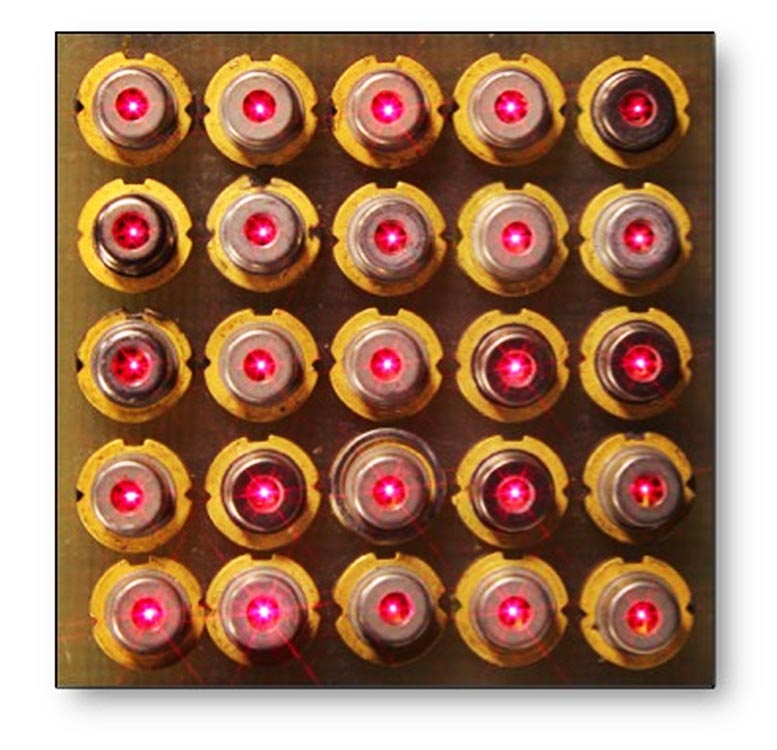
Researchers invent a novel vertical-cavity surface-emitting laser, the workhorses of data centers and optical sensors.
Summary
Researchers at the George Washington University have developed a new design of vertical-cavity surface-emitting laser (VCSEL) that demonstrates record-fast temporal bandwidth. This was possible by combining multiple transverse coupled cavities, which enhances optical feedback of the laser. VCSELs have emerged as a vital approach for realizing energy-efficient and high-speed optical interconnects in data centers and supercomputers.
The Situation
VCSELs are a vital class of semiconductor laser diodes accompanying a monolithic laser resonator that emits light in a direction perpendicular to the chip surface. This class of lasers is gaining market importance given their compact size and high optoelectronic performance. As miniaturized lasers, they are used as an optical source in highspeed, short-wavelength communications and optical data networks. Dense traffic and high-speed transmission are key requirements for smart sensor applications in automotive or data communications, which are enabled by compact and high-speed VCSELs. However, the 3-dB bandwidth, known as the speed limit of VCSELs, is limited by thermal effects, parasitic resistance, capacitance and nonlinear gain effects.
The Solution
Direct modulation of VCSELs cannot exceed about 30 GHz due to nonlinear optical amplification effects known as gain relaxation oscillations. This invention introduces a revolutionary novel VCSEL design. Since feedback inside the laser needs to be carefully managed, researchers introduced a multi-feedback approach by combining multiple coupled cavities. This allowed them to strengthen the feedback known as “slow-light,” thus extending the temporal laser bandwidth (speed) beyond the known limit of the relaxation oscillation frequency. The innovation is ground-breaking because the direct feedback from each cavity only needs to be moderate and can be controlled precisely via the coupled cavities, allowing for a higher degree of design freedom. Following this coupled cavity scheme, a resulting modulation bandwidth in the 100 GHz range is expected.
From the Researchers
“Here we introduce a paradigm-shift in laser design. We utilize a novel coupled cavities approach to carefully control the feedback to the laser achieved by significantly slowing the laser light down. This coupled cavity approach adds a new degree of freedom for laser design, with opportunities in both fundamental science and technology.”
— Volker Sorger, associate professor of electrical and computer engineering at the George Washington University.
“This invention is timely since demand for data services is growing rapidly and moving towards next generation communication networks such as 6G, but also in automotive as proximity sensor or smart phone’s face ID. Furthermore, the coupled cavity system paves a way for emerging applications in quantum information processors such as coherent Ising machines.”
— Dr. Hamed Dalir, co-author on the paper and inventor of the technology
Reference: “Hexagonal transverse-coupled-cavity VCSEL redefining the high-speed lasers” by Elham Heidari, Hamed Dalir, Moustafa Ahmed, Volker J. Sorger and Ray T. Chen, 15 October 2020, Nanophotonics.
DOI: 10.1515/nanoph-2020-0437
Never miss a breakthrough: Join the SciTechDaily newsletter.
1 Comment
Very Interesting.
Well done.
Some thoughts and suggestions for consideration to take this technology to next level.
1. LASER – Light Amplification by Simulation Emission of Radiation Breakthrough. The Device Produces and amplifies light which has unique properties , which is impossible to obtain by any other known means and is produced by Atomic Means.
2. Light is two-faced like Janus. Sometimes it behaves like a particle and can pos sibly travel at speeds exceeding 617,629,,629 miles per hour in a Vacuum. When Light behaves as Particle , Light will have a Mass and Speed and it may be two dimensional in nature. Sometimes Light can behave like a wave. When behaving like a wave both light and sound have properties of wavelenght, frequency, and Amplitude. When light behaves like a wave it may be three dimensional in nature. so the constant speed of light maybe different than when it is 2-D in nature ( 186, 282 miles per hour!). When Light Changes its nature from Particle to Wave and Vice-Versa is not known and the mathematics of the same may need to be better understood. Maybe Bhors Uncertainty principle and Schrodingers “Dead Cat” equations may have a role to play. LASER is a Unique Form of Light. The speed of this Modified form of Light with its Unique Properties can vary rom 68 miles per hour to 300 times the known speed of light [ J Wang et al – Nature 406217] – July 19, 2000. Maybe development of this technology , will enablle us to Trek the Universe at speeds unimaginable currently. Gokus top speed estimate is 33,314 times the speed of Light! Tachyons are Theoritically predicted to exist at speeds faster than the speed of light – Gerald Feinberg – 1967.
3. Use the concept of illogical Logic in thinking. It is likely to lead to breakthroughs.
4. Neutrinos travel at sub-light speeds – 5 teams have confirmed. Control Speed, Amplitutude , Frequency , and Wavelength of this Unique form of light (Light) and Sound wavelength —- to determine the most appropriate form of these two elements of nature for use in medical technology and cure all illnesses. ASIDE! Aways wondered if Sound also exists in Particle Form? Well After listening to Hard Rock & Metalica Music , I beleive that it is the particle form of Sound enters our eardrums. Classsical Music from alltradations across the globe are the wave form of Sound entering our eardrums!
5. Coming back to the new technology breakthrough . Some Ideas . (a) Can this technology be extended to Fibe Optic Transmission to further minimise transmission losses? (b) Can it be extended to Sattelite & Direct to Home Technologies? (c) Can we figure out how to extend the three DB bandwidth by overcoming and addressing the known limitations? (d) Can we extend the nullification of the gain relaxation osciilations and explore multiple coupled diodes to extend the range beyond 100 GHz?
5.